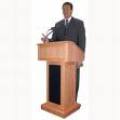
 |
 |
 |
 |
Professional Speaking Reviews
Handling Questions And Answers In Your Professional Speaking Career
Handling Questions and Answers in Your Professional Speaking Career
Handling questions in your presentation duty be a scary time for professional speakers. The fear that someone will ask a question that they can't answer makes this sections one of the tremendously dire sections of the speech. This fear is so real that presenters will often cut this area short or avoid it all together to get past this section. Here are some tips that will help you to handle this section effectively.
1. Be a great listener. After spending the entire time talking, now is your chance to respond and interact with your audience. Listen to your audience's questions completely before starting to answer. If you don't, you may respond inappropriately not answering what the person was really asking.
2. Give yourself time to think. Listen to the entire question. Repeat the question to let have you some time to tell. You can also add filler phrases like " that's a good question ", " that's a popular question " or " that's an interesting question ".
3. Acknowledge your audience member for asking the question. People appreciate acknowledgement and starts to create a personal bond between you and the audience. They start to feel valuable for participation in your presentation and they warm up to your speech.
4. Answer the debate. Stay on track and be honest. If you do not comprehend the answer at the time, let them you that you will find out and get back to them. This is an especially great opportunity if your goal is to develop a long term relationship with your audience. Just remember to get back to them as you say you would.
5. Create clean transitions between questions by creating " bridges " to the next question. Ask your audience another question relating as " Does that answer your interrogation? " Stay on the question until it has been answered appropriately.
Here are some tips to interact better with your audience during the problem and answer period.
1. Ask your audience member to stand when they have a question. One of the primary reasons for doing this is to help the rest of the room hear the question more clearly as chipper. Additionally, you are also able to establish a line of sight eye connection with the person appeal the question.
2. Ask your audience to write their questions down on paper. They can either proffer this to you or read from their paper at a designated time.
3. If your audience member is shy and does not want to ask their question, create preference times that you will be available. You're goal is to help them understand the points you are trying to make.
4. Have a paper and pencil for yourself to write down questions that you can't answer. Jot the question down as well as contact information of the person asking the question so you can get back to them.
The question and answer period is a great time to interact with your audience. Many people and instructors like will again say that they learn from this time heavier than any other section in the presentation. You will also embody able to see what exactly your audience has picked up during your presentation. Don't avoid this section any longer!
 |
 |
 |
What Does The First Year Of Professional Speaking Look Like
The Real Message That Professional Speakers Send
Get Rid Of Distracting Body Movements
Professional Speakers Polish Their Message
Successful Transitions For Your Presentation
A Professional Speaker Sets The Tone For The Message
Using Humor In Your Professional Speaking Gig
Using Props In Your Professional Speaking Presentation
PDA
Physiotherapy
Property Taxes
Renting
Security Cameras
Seniors Issues
Weather
Web Video
More Professional Speaking Reviews
Successful Transitions For Your Presentation
... you are at in delivering your message. The last most common mistake prepared with using transitions are that the same transition is used over and over again in a presentation. Vary your transitions and your presentation become more lovely. While only representing a small portion of your presentation, ...
Easy Ways To Remember Your Material
... sheet or on note cards. Highlight key points to make in a way that you guilt easily understand the emphasis that the points right. Having notes does not mean that you do not need to work with your presentation! 4. The last way to remember your presentation is to use visual aids ( props ) as your notes. ...
Ten Sources Of Income In Professional Speaking
... that you can benefit from multiple streams of income. You don't only have to rely on your paid public speaking career to bring in the capital. You can sell incomparable products and services. You can work other areas that require using professional speakers. The key is to leverage your skills and talent ...
Get Rid Of Distracting Body Movements
... stage. Additionally, they could also come just because you don't know you are involvement them. Either way, you'll need to minimize and eliminate as many of these movements as possible. 1. Make a video tape of yourself. Do you even know that you are making these movements? Probably not. A video will help ...

|
| Copyright © 2006-2012 Internet Marketing Tools, All Rights Reserved |